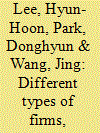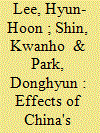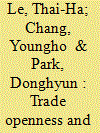|
|
|
Sort Order |
|
|
|
Items / Page
|
|
|
|
|
|
|
| Srl | Item |
| 1 |
ID:
113696


|
|
|
|
|
| Publication |
2012.
|
| Summary/Abstract |
The role of China in East Asia's recovery from the recent global financial and economic crisis highlights China's position as an engine of growth for this region. From the viewpoint of China, there are many potential gains from entering into free trade agreements (FTAs) with its neighbors, who collectively form a large and fast-growing market. In this paper, we qualitatively and quantitatively assess the four main permutations of China's FTAs with East Asian major economies: China-ASEAN, China-Japan, China-Korea and ASEAN+3. We compare the effects of these FTAs on China's output and welfare. Our comparative analysis shows that China will gain from all three bilateral FTAs, while gaining the most from the ASEAN+3. Because forming a region-wide FTA, such as the ASEAN+3, is expected to be gradual and difficult, China should continue to engage in bilateral FTAs as a medium-term and alternative strategy. However, in the long term, China should pursue a region-wide FTA.
|
|
|
|
|
|
|
|
|
|
|
|
|
|
|
|
| 2 |
ID:
120623


|
|
|
|
|
| Publication |
2013.
|
| Summary/Abstract |
Using highly disaggregated HS 8-digit product-category level data collected by the Chinese Customs Office for 2000 and 2008, we perform an in-depth anatomy of China's imports of manufactured goods. We estimate both the extensive margins - number of products imported per product group or trade partner - and intensive margins - amount of imports per product group or trade partner - of China's imports. Our paper contributes to the literature of firm heterogeneity in international trade in three different ways. First, we distinguish firms into foreign firms and domestic firms, which are further divided into private firms and public firms. Second, we distinguish products into final goods and intermediate goods. Third, we estimate gravity equations from the perspective of dynamics utilizing a dynamic adjustment model. Overall, our analysis yields a number of new stylized facts about China's imports. These, in turn, help us to gain a fuller understanding of China's trade patterns in light of its recent emergence as a globally significant importer.
|
|
|
|
|
|
|
|
|
|
|
|
|
|
|
|
| 3 |
ID:
153053


|
|
|
|
|
| Summary/Abstract |
The Chinese economy is slowing down and is in the midst of a structural transformation from export-led and investment-led growth to domestic demand-led and consumption-led growth. While there are widespread concerns among China's trading partners about the effect of the slowdown in China's growth on their exports, China's structural changes are also likely to have a significant impact: for example, China will import fewer machines and more cosmetics. The central objective of the present paper is to empirically examine the effect of China's structural transformation on the exports of East Asian economies, which have close trade linkages with China. We find that economies that have failed to increase the share of consumption goods in their exports to China have suffered larger declines in their quantities of exports to China. In addition, economies that have suffered losses in their shares of China's parts and components imports have faced reductions in their shares in China's total imports.
|
|
|
|
|
|
|
|
|
|
|
|
|
|
|
|
| 4 |
ID:
090112


|
|
|
|
|
| Publication |
2009.
|
| Summary/Abstract |
The current global financial and economic crisis is giving new life to initiatives that promote closer economic integration among East Asian countries. A significant example is the ASEAN-China Free Trade Area (ACFTA), which is set to come into effect around 2010. ACFTA aims to boost trade between two economies that are partners as well as competitors: ASEAN and China. In the present paper, we use insights from customs union theory in a qualitative analysis considering whether ACFTA would benefit both sides. We also apply a computable general equilibrium model to perform a quantitative analysis of the same issue. Both our qualitative and quantitative analyses provide grounds for guarded optimism regarding ACFTA's prospects as a vehicle for strengthening the economic partnership between ASEAN and China.
|
|
|
|
|
|
|
|
|
|
|
|
|
|
|
|
| 5 |
ID:
111870


|
|
|
|
|
| Publication |
2012.
|
| Summary/Abstract |
The current global economic crisis has alerted East Asian countries to the risks of excessive dependence on exports to the United States and EU. This shared sense of vulnerability is likely to promote regional economic integration. In particular, intra-regional trade is now viewed as a new potential engine of growth. The ASEAN-Korea Free Trade Area (AKFTA) is a concrete example of this general trend. This paper qualitatively and quantitatively examines the economic feasibility and desirability of AKFTA - qualitatively using the theory of economic integration and quantitatively by applying a CGE model. Our analysis provides some grounds for optimism about AKFTA's prospects.
|
|
|
|
|
|
|
|
|
|
|
|
|
|
|
|
| 6 |
ID:
150459


|
|
|
|
|
| Summary/Abstract |
We examine the relationship between trade openness and the environment in a cross-country panel, using the emission of particulate matter (PM10) as the basic indicator of environmental quality. The panel cointegration test results show a long-run relationship between particulate matter emissions, trade openness, and economic growth. We find that increased trade openness leads to environmental degradation for the global sample. However, the results differ according to the income of countries. Trade openness has a benign effect on the environment in high-income countries, but a harmful effect in middle- and low-income countries. These results are generally robust to different measures of trade openness and environmental quality. Interestingly and significantly, the results are consistent with the popular notion that rich countries dump their pollution on poor countries. Finally, we find evidence of a feedback effect between trade openness and particulate matter emissions for the global sample as well as different income groups of countries.
|
|
|
|
|
|
|
|
|
|
|
|
|
|
|
|
|
|
|
|
|